
Biogas is a renewable energy source with great potential, but it has challenges. Containing biogas is essential for safety and efficiency, and this is where geo-membranes come in. Geo-membranes are geosynthetic materials made from polymers like polyethylene, polypropylene, and polyvinyl chloride. Their unique properties make them an ideal solution for capturing and containing biogas, and they offer numerous benefits over traditional containment methods. Read on to know more about these membranes.
Benefits of Geo-membranes for Biogas Containment
Thanks to their high strength, low permeability rates, and wide range of thicknesses, geo-membranes are the ideal solution for biogas containment. A geo-membrane’s ability to prevent gas transmission is measured by the perm rating. The perm rating indicates the transmission rate of gases through the geo-membrane. When selecting a geo-membrane, choosing one with a perm rating that’s as low as possible is important. This ensures that the Biogas Membrane will be contained. Here’s more on the benefits.
- Enhanced Safety: Geo-membranes are an inherently safe method of biogas containment. They are highly resistant to chemicals, which means liquids like acids and salts won’t be able to penetrate the geo-membrane.
- Ease of Installation: Geo-membranes can be installed on either land or water. They are lightweight, easy to cut, and require no heavy equipment for installation.
- Durability: Geo-membranes are extremely durable and can withstand temperatures up to 200 degrees Fahrenheit.
- Extensibility: Geo-membranes can be used as a single- or double-walled containment system and can be tailored to fit the specific needs of each project.
- Low Maintenance: In most cases, geo-membranes only need to be inspected once a year. They are easy to clean, and there’s no risk of corrosion.
Factors to Consider When Choosing a Geo-membrane
When choosing a Geomembrane, it’s important to factor in the project’s size and scope. Geo-membranes come in various sizes and thicknesses, so choosing one that is appropriate for your project is important. It’s also important to note that thicker geo-membranes take longer to install. As such, the project’s size and scope should be considered when choosing the geo-membrane’s thickness.
- Gas Transmission Rate – The gas transmission rate indicates the rate at which gases are transmitted through the geo-membrane. The lower the transmission rate, the better.
- Thickness – Geo-membranes are measured in mils, indicating the material’s thickness. The thicker the geo-membrane, the more durable it will be.
- Installation Type – Geo-membranes that are cut to size and installed with an adhesive require minimal equipment, but geo-membranes that are installed in a continuous roll require more equipment.
- Maintenance Needs – Geo-membranes vary in the frequency with which they need to be inspected. It’s important to select a geo-membrane with a maintenance schedule that fits into your project’s timeline.
Installation and Maintenance Tips
When installing geo-membranes for biogas containment, it’s important to follow the manufacturer’s instructions carefully. Incorrect installation can lead to leaks and other issues, so it’s important to use best practices. In most cases, geo-membranes are installed in a roll-on, roll-off method. It’s important to consider the project’s timeline and the equipment required for installation. Geo-membranes can be cleaned with water and a mild detergent, but it’s important to avoid using solvents. After installation, it’s important to monitor the geo-membrane for any signs of wear, tear, or damage. It’s also important to conduct routine inspections to ensure the geo-membrane is intact and not leaking.
Conclusion
The use of geo-membranes for biogas production has become increasingly popular in recent years. This innovative technology offers several benefits, from improved efficiency and cost savings to greater environmental sustainability. Geo-membranes are water- and gas-impermeable synthetic membranes that line biogas containment systems, such as anaerobic digesters.
Interesting Related Article: “Exploring geosynthetics“
